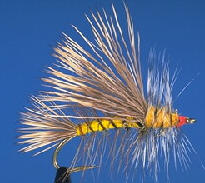On The Fly
"Fly tying is a school from which we never graduate"
 TYING NEWS
TYING NEWS
The Rogue Flyfishers' fly tying classes are overbooked for the upcoming sessions.
You are welcome to contact Dan Kellogg or Johnny Hale if you desire to put your
name on the overflow list. Occasionally we have dropouts from the classes so it
doesn't hurt to get your name on the overflow list. The classes start Tuesday,
February 1st and run for six weeks each Tuesday evening from 7 to 9 p.m. at the
Medford Library. Johnny Hale will teach the beginners and I will be teaching the
intermediate-class tiers. Materials will be provided so students need only bring
a vise, tools, and thread.
Some of our beginners have lots of desire to learn but not the tools to get started. If any RFF member has extra tools or materials to donate or loan to this very worthy cause, we would appreciate it. Like rods and reels, your donation will be used over and over in the future classes to spark the new generation's passion for the art. The future of our club depends on beginners and young people to carry on this passion. Please help if you can.
The next meeting of the Southern Oregon Fly Tiers will be held on January 27th at the Rogue River Library. Final preparations for our library displays will be gathered. We will have demos, a guest tier, a fly exchange, and lots of fun for all. Please accept our invitation to attend the forth Thursday of each month.
 PATTERN OF THE MONTH -
PATTERN OF THE MONTH -
Kaufmann's Stimulator
Hook: 2X or 3X long dry fly, TMC 200R, Mustad 79580, size 4 - 16
Thread: Orange 6/0 or 3/0
Tail: Elk or deer body hair
Abdomen: Yellow/orange dubbing
Rib: Brown or grizzly hackle, palmer style, smaller than hook size.
Thorax: Orange dubbing
Wing:Elk
Hackle: Grizzly over thorax, dry fly style
Tying Instructions:
1) Tie in a clump of elk or deer for the tail, extending the tail
beyond the bend of the hook about 1½ times the hook gape.
2) Tie in brown or grizzly hackle for a palmer rib and dub a tapered
yellow/orange body forward to about 2/3 the length of the shank.
3) Wrap the hackle forward, palmer style over the abdomen. Tie off and
tie in the wing of elk hair such that the end of the wing is even with the bend of the hook.
4) Tie in a second hackle and dub the thorax forward to just behind the hook eye.
5) Wrap the hackle forward, dry fly style, and tie off.
6) Whip finish and go fishing.
This month's pattern is a great all-around attractor fly and works so well it should be included in your fly box. Kaufmann's Stimulator is nationally heralded, is almost worshiped in the American West, and has an international following from New Zealand to the mountains of Sweden. The fly is truly an attractor for all occasions and can be fished in sizes 4 to 16, with features of both stoneflies and caddis, but also works as a hopper imitation.
What makes the Stimulator so effective? When asked that question Randall Kaufmann stated that he honestly didn't know but said "The Stimulator may be just different enough that fish do not remember having an earlier encounter with it and mistake it for real food." He also admits that it is not unique, but is kind of a composite of "parts" from other effective flies. In the new millennium, there are very few things that are truly brand new. In fact, genius is often in the ability to synthesize, rather than create.
So why does the Stimulator work? According to Randall "By tying it wide (spreading out its tail and wing) and tall with the wing spread upward, the fly creates the illusion of bulk and the blurred or fluttering image of wing movement. Palmered hackle adds to this illusion, and it should be stiff and tapered, smaller at the tail area. These features, along with fishing them when they are in good condition, ensures they react to tiny individual currents, portraying a buoyant, animated natural insect."
If you fish anywhere in the west, or New Zealand to Sweden, and haven't tied up some Stimulators, try it this year. Stimulators are easy to tie and by varying the color combinations and sizes, they offer almost a full fly box of variety. Yellow is an excellent all around color but orange, olive, and black can be very effective. The all-black version is particularly effective and quite visible at dusk. You can also consider changing hackle colors. I prefer using grizzly for the body hackle but some tiers swear by brown hackle. On occasion I will change the thorax hackle to brown dyed grizzly, dark dun or olive dyed grizzly.
Whatever the Stimulator is doesn't really matter. What does matter is that the fly works and works very well. Tie some up and take them out for a test flight.
Tie One On,
Dan Kellogg (you can contact me at FLYGUY@EZNORTHWEST.COM)